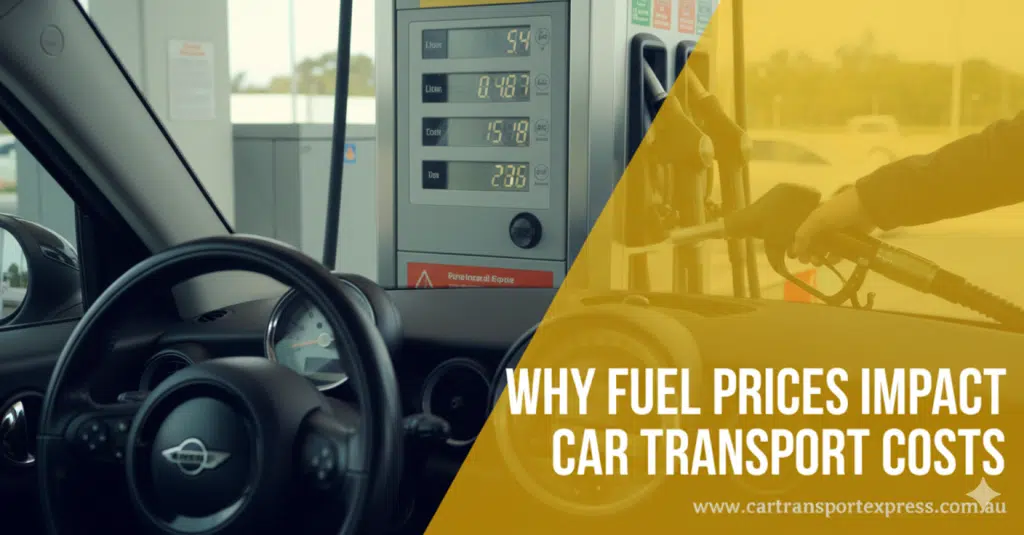Why Fuel Prices Impact Car Transport Costs in Australia

3 min read
Key Takeaways
- Fuel is a core operating expense, Diesel makes up one of the biggest costs for car transporters, and even small price increases per litre significantly raise overall transport costs.
- Global and local factors drive fuel prices, Oil markets, exchange rates, taxes, and regional supply issues all contribute to fuel price volatility in Australia.
- Long distances amplify costs, Remote and interstate routes consume more fuel, making long-haul car transport more sensitive to fuel price changes.
- Fuel surcharges are common, Many carriers include surcharges or flexible pricing mechanisms to account for fluctuating diesel prices.
- Operators use strategies to cut fuel risk, From efficient route planning to backloading trips, transport companies aim to reduce fuel expenses where possible.
- Customers should compare quotes carefully, Always ask whether fuel is included, check for surcharge clauses, and be cautious of quotes that seem unusually low.
When you request an interstate car transport service, one of the biggest cost drivers is fuel. Understanding exactly why fluctuations in fuel prices affect vehicle shipping costs can help you anticipate quote changes and choose a transport provider wisely.
Below is a breakdown of how fuel affects the bottom line in car transport across Australia.
1. Fuel Is a Core Operating Expense for Transporters
Fuel isn’t a marginal cost for car carriers, it’s one of the largest ongoing expenses.
- Every kilometre the trailer travels consumes diesel (or fuel) and as prices rise, the cost per km increases.
- For long interstate hauls, small increases per litre snowball into significant additional costs.
- Transport companies often build fuel costs into their basic pricing models and adjust them as fuel prices change.
- Many providers add a fuel surcharge to their base cost to manage volatility, this surcharge may vary depending on current diesel prices.
- Because of this, when petrol or diesel prices jump, the transport operator’s margin is squeezed unless they pass some or all of that increase to the customer.
2. Diesel Prices in Australia Are Affected by Global and Domestic Factors
Understanding why fuel costs fluctuate helps explain why transport quotes aren’t static.
- Australia imports a portion of its refined fuel, so international crude oil prices and supply disruptions have a direct impact.
- Exchange rates matter: when the Australian dollar weakens versus major currencies like the US dollar, imported fuel becomes more expensive.
- Government levies fuel excise and GST are built into fuel prices.
- Local distribution, transport of fuel itself, and regional variances (e.g., remote areas) also influence pump prices.
Because of these interconnected factors, fuel prices in Australia can shift within weeks or even days, and carriers must respond.
3. Long Distance Hauls Amplify Fuel Cost Impacts
Transporting cars across states often means long stretches between major hubs, sometimes through sparsely populated regions. That amplifies fuel cost sensitivity:
- Every extra litre used on remote stretches is more expensive in absolute terms than in dense areas.
- The farther a route, the greater the proportion of fuel cost relative to fixed costs (driver wages, maintenance, overhead).
- Carriers may need to detour or take less efficient routes, often due to roadworks or restricted access, increasing fuel consumption.
Thus, routes with greater distance or low frequency demand will tend to carry higher margins or surcharges.
4. Fuel Surcharges and Pricing Mechanisms
Because of volatility, many car transport providers use fuel surcharges or escalation clauses to manage risk:
- Instead of quoting a single fixed price, the base rate might exclude fuel fluctuations, with surcharges added based on recent diesel price indexes.
- Some quotes offer “locked-in” fuel pricing for a period; others adjust dynamically.
- It’s common that the surcharge isn’t highlighted clearly in the initial quote, so clients should ask specifically whether fuel is included or if a surcharge may be added later.
Understanding how a carrier handles fuel will help you compare true apples-to-apples costs.
5. Strategies Transporters Use to Mitigate Fuel Risks
To manage rising or volatile fuel costs, transport companies often adopt strategies to reduce
Sensitivities:
- Route optimisation software to shorten distance or avoid traffic delays.
- Fuel-efficient vehicles and trailer designs (improved aerodynamics, lighter materials).
- Bulk fuel purchasing contracts or hedging to lock in lower fuel prices.
- Preventative maintenance and driver training to reduce fuel wastage (e.g. smoother
- acceleration, fewer idle times).
- Backloading or return trips, combining trips so carriers don’t travel empty.
As a client, you may not see all these behind the scenes, but more efficient operators are better positioned to manage fuel-driven cost pressure.
6. What It Means for You as a Customer
Knowing how fuel prices drive costs in the background helps you make smarter decisions:
- When receiving quotes, ask whether fuel is included or whether there is a fuel surcharge clause.
- For longer or remote routes, expect higher sensitivity to fuel changes, so get timeframe flexibility where possible.
- Look for carriers who transparently disclose their pricing models (base cost + surcharges) so you understand what can change.
- Because fuel is unpredictable, booking earlier may lock in better rates.
- Be wary of unusually low quotes, they may assume fuel stays low and may add hidden surcharges later.
Conclusion
Fuel costs are one of the most important factors influencing the price of car transport in Australia. Global oil markets, exchange rates, taxes, and domestic distribution all impact diesel prices and these changes flow directly into the cost of moving vehicles. By understanding these dynamics, customers can better plan, compare quotes effectively, and avoid unexpected surprises in their transport costs.






